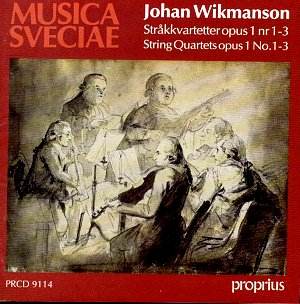Wikmanson plied his unlikely trade as a professional
accountant working for the new Swedish National Lottery. He also
pursued concurrent musical appointments as an organist and as
a significant figure in the musical and cultural life of his country
though it was the nature of his profession that he was regarded
as something of a musical amateur, a judgement that was reflective
of the relative social standings of official accountant and mere
composer, organist and cellist.
The quartets here were published posthumously
and canít be dated with any real degree of accuracy. They do however
represent his major contribution to musical posterity and were
dedicated on the title page of the first edition by Wikmansonís
wife to Haydn, a fact that establishes definitively where the
Swedish composerís affinities lay. These are felicitous, well-constructed,
well-argued and musical works. They donít establish any great
precedent nor do they show him as a thinker much beyond Haydnís
hegemony but as a sidelight on Haydnís profound influence on specifically
quartet composition in the last quarter of the eighteenth century
they are salutary. The D minor flirts with fugato in its opening
movement but falls back on an attractive series of imitative entries,
charmingly deployed and aerated. I was more struck by the Adagio
in which a rather grandiloquent beginning is followed by some
meltingly affecting writing Ė and powerful work for the first
violin in the cadential end and a concluding unison bleakness.
He can write a perky landler in the Minuet Ė complete with elegant
aloofness Ė and a bustly pizzicato strong finale. In the E minor
heís adept at exploiting quite short paragraphal writing to create
an air of tension and also manages to deploy some earthy Haydnesque
drollery. The adagio is in Haydnís best variational form but the
finale is rather lacking in distinction and the first violin plays
a little roughly as well. Thereís certainly something sprightly
about the B flat majorís opening movement and a real sense of
wistfulness and also elegance in the Romance second movement.
Even these are topped however by the joyful and artless finale
which is pure pleasure from first bar to last.
On balance itís the first of the trio of Quartets
that is the most completely impressive and whilst hardly of profoundly
elevated status, the accountant-composer reveals himself to be
an attractive melodist and a skilful architect of musical structure.
Performances are pretty good from all three quartet groups and
performances derive from Swedish Radio broadcasts from 1983-85;
the group led by Nils-Erik Sparf play on period instruments.
Jonathan Woolf
